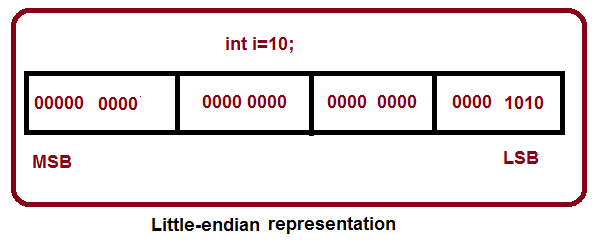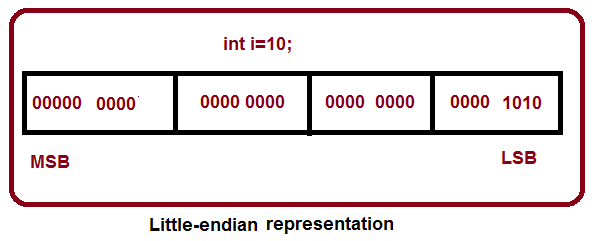
Little Endian and Big Endian in c
What is Endianness
Endianness is the order in which bytes are stored in computer memory. There are two main types of endianness: big-endian and little-endian.
- Big-endian: In big-endian systems, the most significant byte is stored at the lowest memory address.
- Little-endian: In little-endian systems, the least significant byte is stored at the lowest memory address.
What is Little Endians

Little-endian is a term used to describe a computer architecture in which the least significant byte (LSB) of a multi-byte value is stored at the lowest memory address, while the most significant byte (MSB) is stored at the highest memory address. In other words, the bytes are ordered from least significant to most significant.
For example, in a little-endian system, the 16-bit binary number 0xABCD would be stored as CD AB in memory, with the least significant byte (0xCD) at the lowest memory address and the most significant byte (0xAB) at the highest memory address.
Little-endian architectures are used by many modern processors, including x86 and ARM processors. Little-endian byte order is also used in many file formats, including the Windows file system, the Intel HEX file format, and the BMP image file format.
While endianness can affect how different systems communicate with each other, most modern systems are capable of handling both little-endian and big-endian byte orders, allowing for interoperability between different systems.
What is Big Endians
Big-endian is a term used to describe a computer architecture in which the most significant byte (MSB) of a multi-byte value is stored at the lowest memory address, while the least significant byte (LSB) is stored at the highest memory address. In other words, the bytes are ordered from most significant to least significant.
For example, in a big-endian system, the 16-bit binary number 0xABCD would be stored as AB CD in memory, with the most significant byte (0xAB) at the lowest memory address and the least significant byte (0xCD) at the highest memory address.
Some computer architectures that use big-endian byte order include the Motorola 68000, PowerPC, and SPARC processors. Big-endian byte order is also used in some file formats, including the Network File System (NFS) protocol and the Apple Macintosh HFS/HFS+ file system.
While endianness can affect how different systems communicate with each other, most modern systems are capable of handling both little-endian and big-endian byte orders, allowing for interoperability between different systems.
Notes:
- Intel Processor follows little endians
- ARM processor Follows both endians
- Motorola processor follows both endians
- endians is related to OS.
How Do Endians Affect Computer Systems?
Endianness can affect computer systems in a number of ways. For example, it can affect the way that data is transmitted over networks and how data is stored in files.
Data Transmission
When data is transmitted over a network, it is typically broken down into packets. Each packet contains a header, which contains information about the packet, such as its source and destination, and a payload, which contains the actual data.
The endianness of the sending and receiving systems must be the same in order for the data to be transmitted correctly. If the endianness of the two systems is different, the receiving system will not be able to interpret the data correctly.
File Storage
Endianness can also affect the way that data is stored in files. For example, if a file is created on a big-endian system and then opened on a little-endian system, the data in the file will be interpreted incorrectly.
Examples of Endianness
- Big-endian: Most modern processors, such as those used in PCs and Macs, are little-endian.
- Little-endian: Most network protocols, such as TCP/IP, are big-endian.
- Mixed-endian: Some systems, such as the ARM processor, are mixed-endian. This means that they can handle both big-endian and little-endian data.
Endianness Conversion
There are a number of ways to convert between big-endian and little-endian data. One common way is to use the ntohl() and htonl() functions. These functions convert between network byte order (big-endian) and host byte order (little-endian).
Another way to convert between big-endian and little-endian data is to use the swapbytes() function. This function swaps the bytes in a given word.
Conclusion
Endianness is an important concept to understand when working with computer systems. The endianness of a system can affect the way that data is transmitted over networks and the way that data is stored in files. There are a number of ways to convert between big-endian and little-endian data.
Top Resources
Little Endian and Big Endian in c
write a program to prove that we are working on big Endian using union
Write a Program to prove we are working on little Endian environment using a union
Write a program to prove we are working little endian or big endian using character pointer in c
Prove That We are working on Little Endian and Big Endian Using Character Pointer
Enroll Now:
[ C-Programming From Scratch to Advanced 2023-2024] "Start Supercharging Your Productivity!"
Contact Us:
- For any inquiries, please email us at [info@electro4u.net].
- Follow us on insta [ electro4u_offical_ ] for updates and tips.
Note: If you encounter any issues or specific errors when running this program, please let me know and I'll be happy to help debug them!


